|
* Dr. Paul MacCready, founder of AeroVironment, posted this page on his personal web site. As a tribute to one of the brightest, forward-thinking men we've had the pleasure of knowing, we reproduce his photo and the following...in honor of Paul.


Welcome to the AeroVironment Vehicles
page!*
If you
would like to learn about Vehicles, you have come to the right
place!
<

The
following text comes from the short film "Doing More With Much
Less"
"Doing more with
less is a vital feature of a world that works -- where our increasing
demands are met, yet do not overwhelm the limits of the
earth..."
Some of the unusual, efficient
vehicles with which AeroVironment has been involved serve as visual
metaphors for the theme.
Gossamer Condor
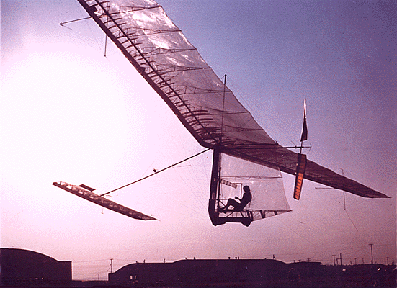 |
The primitive (and fragile) Gossamer Condor
was the first really successful human-powered airplane. The final
version can be seen at the National Air and Space Museum, where it
was installed after this 1977 flight won the first Kremer
Prize. |

Gossamer Albatross
| The
fragile, 70 pound, Gossamer Albatross was pedaled 23 miles across
the English Channel in 1979 to win the largest prize in aviation
history. It demonstrates what can be done with low power, when new
concepts of efficiency are unleashed by challenges not burdened by
constraints from narrow rules or the need for commercial production.
It is a catalyst for new perspectives that can lead to useful
insights and products - such as the Pathfinder. And, incidentally,
it was a tribute to the human
spirit. |
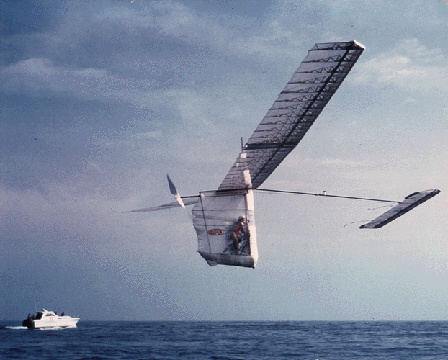 |

Solar
Challenger
 |
The
Solar Challenger was made to serve as a symbol that photovoltaic
cells can produce real power and will be a part of the world's
energy future. In 1981 it flew 163 miles from Paris to England,
solely on the power of sunbeams -- and established a basis for the
Pathfinder. |

QN
Pterodactyl
| QN,
short for Quetzacoatlus northropi, is a flying replica of the
largest natural flyer, a giant pterodactyl. The replica is an
"actor" in the IMAX giant-screen film "On the Wing," which depicts
the evolution of natural flight in relation to the development of
civilization's flying machines. |
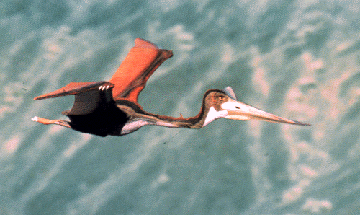 |

GM
Sunraycer
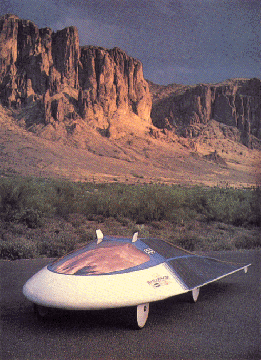 |
In
1987, General Motors teamed with AeroVironment for the rapid
development of the GM Sunraycer, to be entered in the World Solar
Challenge to cross Australia on energy from sunlight. It won,
speeding 50% faster than the runner-up, and averaging 42 miles per
hour on only a kilowatt of power. Batteries to store the
intermittent energy from the sun for vehicle use are essential --
and obviously for non-race purposes, they can be charged from the
utility grid without need for solar cells. This solar car race
helped emphasize that battery-powered cars can make
ssense. |

GM
Impact
| Next,
the same team combined to create the battery-powered Impact
demonstrator. To show that cars emitting no pollution can be part of
our transportation future, it needed adequate range and snappy
acceleration. It zooms from zero to sixty miles per hour in 8
seconds. Now many groups are increasing priorities on
battery-powered vehicles, vehicle efficiency in general, and broader
transportation issues. |
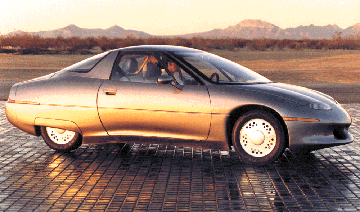 |

Charger Bicycle
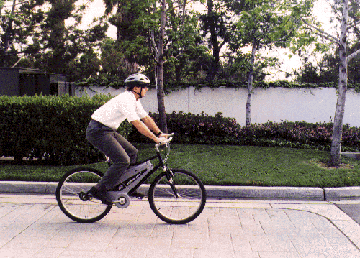 |
Globally, bikes are widely employed for
personal mobility, transport of goods, and recreation. For some uses
battery-assist (a scaled-down version of electric car technology)
makes sense -- you can get the help of a "virtual pedaler", here
hidden in the saddlebags, who weighs only a few pounds and never
talks back -- not to turn your bicycle into a motorcycle, but to let
you do for 30 minutes what your normal ability would let you do for
only 3 minutes. You can extend your commuting range with this
"bionic hybrid" that will never run out of gas. You can match
performance between individuals, or not be bothered by hills on a
hot afternoon. |

AV
Pointer
<
| A
tiny airplane, the AV Pointer, serves for surveillance -- in effect
a pair of roving eyeglasses. A cutting edge example of where
miniaturization can lead if the operator is remote from the vehicle.
It is convenient to carry, assemble, and launch by hand. Battery
powered, it is silent and rarely noticed. It sends high resolution
video pictures back to the operator. With on-board GPS it can
navigate autonomously, and it is rugged enough to "self land"
without damage. |
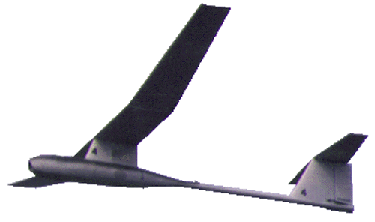 |

Pathfinder
 |
Most
dramatic is the unmanned, 100 foot, solar-powered Pathfinder, here
undergoing low altitude tests in late 1993. Versions are aimed at
"eternal" flight (or at least flights for months, above 65,000 feet)
to carry equipment for surveillance, stratospheric monitoring, and
telecommunications. |

The message from
all these vehicles is that ideas and technology can be harnessed to
produce remarkable gains in doing more with less -- gains that can help us
attain a desirable balance between technology and nature. The stakes are
high, as we speed toward a challenging future.
Buckminster Fuller
said it clearly: "There are no passengers on spaceship earth, only crew".
We the crew, can - and must - do more with less, much
less."
Note:
As AeroVironment focuses on solar powered aircraft, bird-size surveilance planes and other far reaching projects, ElectroPortal has now picked up where Paul and his crew left off...keeping the Charger bikes on the road and designing our own "second generation bike", whatever we end up calling it. It's taken longer to raise the funds from bike sales to provide for the new "Mark II", but after we sell a few hundred more Charger bikes, this bike promises to be a winner too! The longer it takes, the better and more fun-functional it will be...allowing Charger bike owners a chance to upgrade, or hang on to what we believe to be the best e-bike design to date, BAR NONE! < |










